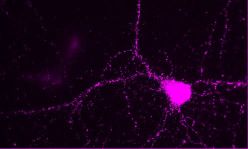News Archive
Molecular basis for memory and learning
 October 2017. Learning and memory are two important functions of the brain that are based on the brain’s plasticity. Scientists from Goethe University Frankfurt report in the latest issue of the scientific journal “Cell Reports” how a trio of key molecules directs these processes. Their findings provide new leads for the therapy of Alzheimer’s disease.
October 2017. Learning and memory are two important functions of the brain that are based on the brain’s plasticity. Scientists from Goethe University Frankfurt report in the latest issue of the scientific journal “Cell Reports” how a trio of key molecules directs these processes. Their findings provide new leads for the therapy of Alzheimer’s disease.
The brain is able to adapt to new situations through changing, building or reducing the contact points between nerve cells (synapses). In particular, the signal strength is regulated by constantly altering the abundance of receptors in the membrane of nerve cells. This explains why it is easier to remember information that we use frequently as opposed to information that we learned years ago and did not use anymore.
Amparo Acker-Palmer’s research group at the Institute of Cell Biology and Neuroscience of the Goethe University focused in their study on AMPA receptors, which are the main transmitters of the stimulating signals. Nerve cells in the hippocampus, the brain region responsible for learning and memory, are able to alter the number of their „switched-on“ receptors by extending or retracting them like antennae thereby regulating the strength of a signal. The Frankfurt scientists now discovered that three key molecules are involved in this regulation: GRIP1, ephrinB2 and ApoER2, the latter being a receptor for the signalling molecule Reelin.
“These results are fascinating since it has been known for years that ephrinB2 as well as Reelin are essential for the development of the brain “ explains Amparo Acker-Palmer. “Furthermore, earlier work in my lab has shown that there is an interaction between the Reelin signalling pathway and ephrinBs when neurons migrate during brain maturation.”
Interestingly, a single mechanism can fulfill very different functions within a cell. An earlier study by Amparo Acker-Palmer’s team already showed that macromolecular complexes consisting of ephrinB2 and ApoER2 regulate processes involved in neuronal migration. In the present study, the scientists selectively inhibited the interaction between the two proteins and could thereby demonstrate that these proteins, together with GRIP1, also influence brain plasticity in adults. When the interaction between these proteins was inhibited, neurons were unable to react to changes in the activity of their network. They also showed defects in long-term plasticity, which is the cellular basis for learning and memory.
“Both, ApoER2 and ephrinB2 molecules have been linked to the development of Alzheimer’s, although the mechanisms of action are not clear yet”, says Amparo Acker-Palmer. “With our research we not only discovered new interactions of key molecules for the regulation of learning and memory but also shed light on potential new therapeutic targets for the treatment of Alzheimer’s disease.”
Contact:
Amparo Acker-Palmer, Institute of Cell Biology & Neuroscience and Buchmann Institute for Molecular Life Sciences, Goethe University Frankfurt, Campus Riedberg, Frankfurt/Main, Germany Tel.: +49 (0)69 798-42563, Acker-Palmer@bio.uni-frankfurt.de
Publication:
Sylvia Pfennig, Franziska Foss, Diane Bissen, Eva Harde, Julia C. Treeck, Marta Segarra, Amparo Acker-Palmer (2017) GRIP1 Binds to ApoER2 and EphrinB2 to induce activity-dependent AMPA receptor insertion at the synapse. Cell Reports 21: 84-96. https://doi.org/10.1016/j.celrep.2017.09.019. Link
Press release of Goethe University Frankfurt

